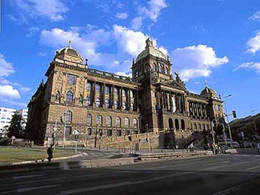
The highway in Prague will be in a tunnel behind the museum, a collapse is reportedly not imminent
 |
The expressway will lose two traffic lanes in the city center. Instead of the current three in each direction, it will have two. "Drivers will be able to bypass the center using the city ring road, and the expressway will become a city street," Šteiner told ČTK today. The capacity of the road would be reduced from the current 85,000 to 50,000 cars per day. According to city politicians, the whole area would be "humanized."
According to today's Deník, the government, the ministries of culture and transport, and the city hall have agreed on transferring the expressway underground in connection with the joint support of the renovation of the National Museum and its connection with the building of the former Federal Assembly. A memorandum on this will be signed on April 29.
The plan to move the expressway behind the museum was presented by the city hall three years ago. The aim is to connect Wenceslas Square with the museum and the pedestrian boulevard with Vinohradská Street. "The first-republic promenade between Vinohradská and Wenceslas Square will return," said Prague 1 councilor Filip Dvořák (ODS) to ČTK today. According to him, people will not have to "shamefully crawl into a hole," meaning the underpass, as is currently the case.
Any traffic complications during the construction of the tunnel will depend, according to the councilor, on how well it is prepared. The Prague 1 municipal office will advocate that work is done around the clock, and that construction lasts as short a time as possible, said Dvořák.
Prague 2 is concerned about the transfer of the expressway without resolving traffic between the fourth and fifth city districts, i.e., between the left and right banks of the Vltava, said deputy mayor Václav Vondrášek (ODS) to ČTK today. "We are very afraid of that; it will congest traffic on the connecting roads, making it unlivable," Vondrášek stated. According to him, another bridge across the Vltava is needed so that not so many cars travel through Prague 2. He also noted that the expressway should not have exits to connecting roads, such as Ječná or Žitná.
On the other hand, councilor Martin Langmajer (ODS) believes that the transfer of the expressway should calm traffic. According to him, the narrowing to two lanes should result in fewer cars entering the expressway. The construction of the Pankrác center, where up to 70,000 jobs are expected to move from the city center, should also help, he said.
Experts in the past have developed two options for eliminating the expressway in front of the museum. One would run behind the building at ground level, while the other would be in a tunnel. They also examined an underground variant. The road should be underground in the section between I.P. Pavlova Square and the Main Train Station. "It will be a kind of tube or collector that will be suspended and insulated, which minimizes vibrations and noise," said Karel Hanzelka, spokesman for the Ministry of Transport, to ČTK.
The costs of the museum's reconstruction are estimated at 4.5 billion crowns. According to Hanzelka, the costs of building the tunnel will not exceed ten billion crowns, and all authorities will contribute to them. It is expected that the Ministry of Transport, or more precisely the State Transport Infrastructure Fund, will contribute four to eight billion, the ministry's spokesman said.
Construction work is expected to begin sometime in 2011. It is estimated to last two to three years. The actual renovation of the museum building should be pointless without resolving the traffic around it.
The transfer of the North-South Expressway will not be the only alteration to the appearance of this part of the center. Prague 1 is advocating for the reconstruction of the entire Wenceslas Square according to a study by the Cigler Marani Architects studio, which won a competition for a new design of the square three years ago. The proposal doubles the width of the sidewalks and adds two rows of trees to the square. It reduces car traffic to a necessary minimum, for example, for deliveries. It also reduces the number of stalls.
According to Dvořák, the councilors of Prague 1 will soon discuss a proposal for the project for modifications to the lower part of the area from Můstek to Vodičkova and Jindřišská streets.
In the area, investors are planning massive construction and renovations of existing buildings, according to the councilor. The city hall will demand that they financially contribute to the modifications of the appearance of the square, just like the investor Palladium, which re-paved Republic Square.
The reconstruction of the upper part of the square will only be possible after an underground tunnel for engineering networks and underground garages, which are very much needed, is built there, said Dvořák. After the reconstruction of the expressway and the construction of garages, the last step would be the potential return of trams to Wenceslas Square. The Prague 1 city hall proposes their route between Vinohradská and Jindřišská with Vodičkova. Earlier, there was consideration of extending the routes to Můstek and building a track in Opletalova Street.
The tram route on Wenceslas Square is not such a priority for the city district as the route to Barrandov was for Prague 5, Dvořák said. However, the city hall of the first city district understands that it is necessary from the perspective of the entire city, as there is practically no replacement for the current route in Ječná Street in this direction.
The English translation is powered by AI tool. Switch to Czech to view the original text source.
0 comments
add comment











